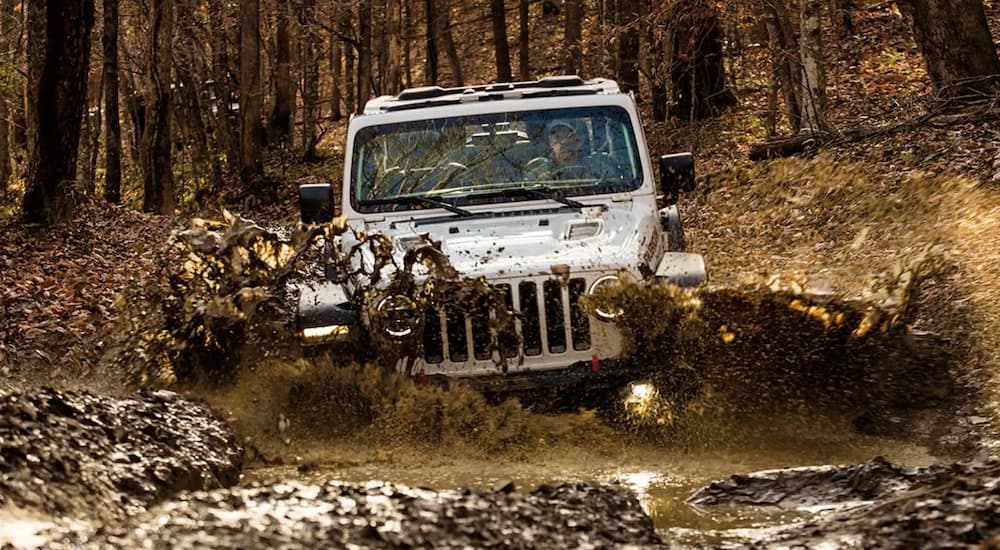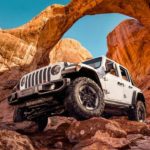Much digital ink has been spilled about this topic, as the Jeep brand is known around the world, not just at your used Jeep dealer. 80 years have come and gone, and through it, the classic Jeep four by four has been a household name in the United States. The Jeep as we know it had a troubled genesis, being built by the likes of Bantam, Willys-Overland, and even Ford. It morphed from wartime transport to a niche utility vehicle used by farmers and ranchers to an SUV marketed as a do anything, go anywhere vehicle.
Who would’ve thought that such a tiny, basic box would be known today for creature comforts? That one day, it would be known as a status symbol? One could buy a used surplus Army Jeep in 1953 for $795, which was the equivalent of $2,122 today. Now, if you want the model that is the closest match to those early Jeeps, you better be prepared to shell out a lot more. The most basic modern Jeep Wrangler will cost you $28,475. That’s quite the change, but we think the Jeep Wrangler is still worth it.
Beginning With Bantam
When Uncle Sam called on US automakers to create a recon vehicle for the sudden war effort during WWII, only two companies put forth proposals, those being Bantam and Willy-Overland, with Ford stepping later in the testing trails. One can see the basic bones of what would become the Jeep we know today all the way back in 1941. The prototype consisted of a boxy, metal “tub” with tough-looking tractor-like tires slung below it. The front end was much more rounded, with round wheel arches and headlights perched upon them. The design of this front end was very reminiscent of the one seen on the trucks produced by GM for the war effort.
Top brass liked the design of the truck but wanted to incorporate some elements of those designs submitted by the other two automakers. Those were the more powerful Go-Devil engine that produced 60 horsepower, supplied by Willys-Overland and the flat fenders and hood design found in the offering by Ford. These design elements were incorporated into one singular design that is the Jeep we all recognize; well, mostly. Unfortunately for Bantam, they didn’t win the contract, as the government felt they lacked the resources to meet demand, and the contract was awarded first to Willys-Overland, and then to Ford later to help beef up production.
Bantam was allowed to build the trailers that would be pulled by these Jeeps, however, so they didn’t lose out completely. Few know that the single-piece stamped grille that Jeep now uses as a logo and the T-shaped hood retainers that each Jeep has featured since its inception were actually a Ford innovation.

Antebellum Aftermath
After WWII, Willys was still left with the contract to produce Jeeps for the US military. In order to fatten their profit margins, they began to sell the Jeep MB slightly repackaged as the Civilian Jeep (CJ), changing only the headlamps, seat and adding a tailgate at that time. The CJ-2A would be marketed to farmers, ranchers as “The All-Around Farm Work-Horse.” The first all-steel Jeep wagon would go on sale in 1946, and the first Jeep pickup truck would appear one year later.
During the Korean War, the US authorized Toyota to help aid the war effort by producing Jeeps under license. It is possible, though unbelievably rare, to find one of these for purchase. It’s also of interesting note that Toyota was instructed to build Japan its own four by four vehicle using a captured Jeep shipped to them in 1941, and it was through that effort that we got the FJ40 Land Cruiser.
Under New Management
Willys-Overland was purchased by Kaiser in 1953, and Kaiser was purchased by the American Motors Corporation in 1969. Under AMC, the first major redesign of the Jeep CJ was seen, making the fenders slightly curved while retaining their flat upper portion. Engines were made larger and more efficient. The AMC line of the Jeep CJ remains popular to this day, and while the company found itself in sharp decline by the time it was purchased in 1978 by French automaker Renault, the Jeep was still riding high. It would be purchased along with AMC from Renault in 1987.
Under its new management, Jeep products like the famous XJ model (the first to bear the Wrangler name) and YJ Wrangler were introduced, losing the CJ designation. The YJ had its fifteen minutes of fame in the first Jurassic Park movie, and it remains one of the easiest “movie cars” to clone, thanks to their wide availability. It is also during this time that the legendary AMC derived 4.0-liter straight-six was introduced. The YJ would be replaced by the round headlight having TJ, which featured airbags and a more modern HVAC system.
The TJ would be the de facto Jeep until 2007, where it was replaced by the Jeep JK. This Jeep is known for popularizing the four-door “Unlimited” model, which has remained the most popular body configuration for the Jeep Wrangler to this day. That model would last for ten years until, in 2017, it would be replaced by the Wrangler JL model of today. Now, you have a large variety of options when you want to buy a Jeep that resembles those first models. There are tons of engines, configurations, and off-road options that make these modern go anywhere, do anything vehicles the perfect companion for any driver.
Moving Forward, Looking Back
The Jeep Brand has expanded into offering many different vehicles in that time: however, they have never stopped selling the Wrangler. In its most current lineup, the Jeep Wrangler JL model can be had as a hyper-efficient hybrid known as the 4xe and as a power breathing show stopper known as the Rubicon 392. This is an Unlimited four-door model with the Rubicon trim package and stuffed with Jeep’s largest engine, a 6.4-liter (or 392 cubic inches, hence the name) V8 engine. Both these are just the latest lineup in Jeep’s long and storied history.
While it has changed hands many times, and new vehicles have been added to the company’s lineup, the classic “Jeep” has remained as an enduring symbol of pride for the company. If you put two white circles on either side of seven white vertical bars, almost everyone can tell what you’re trying to represent. It’s just that iconic. The logo can be seen on hats, shirts, mugs, flags, and even etched into the windows of modern Wranglers from the factory.
What started out as a desperate grab for wartime supplies began an 80-year odyssey for the little SUV. It went from a farmer’s tool to something that wouldn’t look out of place parked outside a yacht club. The first Jeeps were little more than metal boxes on stiff chassis, meant to be torn down and serviced easily. Modern Jeeps are status symbols and can be had with all kinds of cutting-edge technology. The modern Jeep Wrangler has very little in common with its descendant of WWII, but its roots live on in one of America’s favorite vehicle models.





